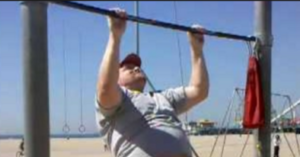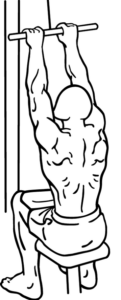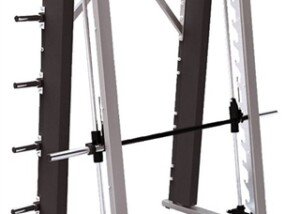
Yes, overweight people can learn to do a pull-up with my safe, motivating approach to training for this stellar exercise.
When I say that overweight people can develop pull-up ability, I’m not talking about obese or “fat” people.
I’m referring to slightly or mildy overweight people, or those with the so-called thick or husky body.
Pull-ups are inherently very difficult to do. A thin person who doesn’t train will not be able to do a pull-up.
A true pull-up, with no cheating, is done by first hanging still, so that the overweight person can’t use momentum or leg swings to help get up.
You then, with control, pull yourself up, without legs kicking all over the place.
The human body was not designed like a lower primate’s, with the innate strength to hang and pull up.
A person in poor condition, even a skinny person, will feel very uncomfortable only hanging, and the pull-up will be impossible.
So you can imagine how difficult a pull-up can be for someone carrying 20 or 30 extra pounds.
First, the overweight individual must get used to working out with the pull-over or “lat pull-down” machine.

Everkinetic, CreativeCommons
This will train and condition the joints to bring down a heavy weight. Do not use a very wide grip. This is not necessary and will only add strain to the shoulder joints.
Grip can be shoulder width to more than shoulder width apart, but not too wide. The overweight person should focus on building up significant strength with this maneuver.
Additionally, spend some time with the pull-up assist machine. Most gyms have one.
But set the assistance so that you can barely perform 8 repetitions. If you can do more than 8, then the assistance is too much.
Remove some of it and try again. Rest 1-2 minutes in between sets, and do four sets. Each rep should be difficult, with the last one almost impossible.
After an overweight man or woman has developed the ability to bring down quite a bit of weight, and has been using the assist machine for a while and has noticed improvement (using less assistance as weeks go on), next is to try a pull-up with hands a little less than shoulder width apart.

Shutterstock/Pressmaster
But first, hang for a few moments. Rest. Hang again. Rest. Hang again. Just get used to hanging.
If you can get up only halfway, don’t despair. This is the beginning of learning to do pull-ups for the overweight person.
Rest a few minutes, then try another. If it’s only halfway, that’s fine. Eventually you’ll be able to get yourself all the way up.
I strongly advise AGAINST the idea of holding onto the bar and then jumping off the floor to get your body up and doing this repeatedly like you have ants in your pants.
This won’t cut it. You’ll be at this for months on end and still won’t be able to do one actual, genuine pull-up.
Forget this method. It can harm shoulder joints, and it looks ridiculous, I might add.
When you get to achieving one full pull-up, pat yourself on the back, and work from there. Over time, one pull-up will turn into two, and so on. It will take time.
Perform your back exercises one to two times per week, and include seated rows with heavy resistance.
Mildly overweight people with healthy shoulders, and with patience and persistence, can learn to do pull-ups, one of the best compound movements.


























